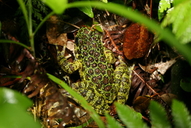|
Description
The body of this species is slender. The canthus is blunt, and the tympanum is circular. The hindlimb webbing is moderate. The skin on the back is scattered with large warts which contain radiating striae and are surrounded by tubercles. There are 1-7 vomerine teeth. The tips of the fingers and the toes have large discs with circummarginal grooves. There is no dorsolateral fold. The mean snout to vent length for males is 97 mm (range 88-106)and for females it is 110 mm (range 105-117). There are a pair of vocal sacs and openings at the corners of the mouth. The males have nuptial pads that are yellowish brown and poorly developed. Distribution and Habitat
Country distribution from AmphibiaWeb's database: Japan
This species is found on the islands of Amamaioshima and Okinawajima in Japan. It lives near streams in mountainous forests.Life History, Abundance, Activity, and Special Behaviors
R. ishikawae breeds from January to May in small pools in the cracks of large rocks or underground on the banks of streams. The mating call has one note that lasts for 0.6 seconds. 1,000 creamy eggs with a diameter of 2.9-3.5 mm are laid. Comments
The population from Amamioshima differs morphologically and karotypically from Okinawajima population and could be differentiated at the subspecies level.
References
Maeda, N. and Matsui, M. (1990). Frogs and Toads of Japan, 2nd edition. Bun-Ichi Sogo Shuppan Co., Ltd., Tokyo, Japan.
Originally submitted by: Ambika Sopory (first posted 2001-10-26)
Edited by: Vance T. Vredenburg (2001-12-18)Species Account Citation: AmphibiaWeb 2001 Odorrana ishikawae: Ishikawa's frog <https://amphibiaweb.org/species/5060> University of California, Berkeley, CA, USA. Accessed May 20, 2025.
Feedback or comments about this page.
Citation: AmphibiaWeb. 2025. <https://amphibiaweb.org> University of California, Berkeley, CA, USA. Accessed 20 May 2025.
AmphibiaWeb's policy on data use.
| 




 Map of Life
Map of Life